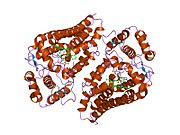Indoleamine 2,3-dioxygenase
Indoleamine-pyrrole 2,3-dioxygenase (IDO or INDO EC 1.13.11.52) is an immunomodulatory enzyme produced by some alternatively activated macrophages and other immunoregulatory cells (also used as an immune subversion strategy by many tumors). In humans, IDO is encoded by the INDO gene.[1][2]
Interferon-gamma has an antiproliferative effect on many tumor cells and inhibits intracellular pathogens such as Toxoplasma and chlamydia, at least partly because of the induction of indoleamine 2,3-dioxygenase. This enzyme catalyzes the degradation of the essential amino acid L-tryptophan to N-formylkynurenine.[3]
IDO is the first and rate-limiting enzyme of tryptophan catabolism through kynurenine pathway, thus causing depletion of tryptophan which can cause halted growth of microbes as well as T cells.
See also
References
- ^ Dai W, Gupta SL (1990). "Molecular cloning, sequencing and expression of human interferon-gamma-inducible indoleamine 2,3-dioxygenase cDNA". Biochem. Biophys. Res. Commun. 168 (1): 1–8. doi:10.1016/0006-291X(90)91666-G. PMID 2109605.
{{cite journal}}: Unknown parameter|month=ignored (help) - ^ Najfeld V, Menninger J, Muhleman D, Comings DE, Gupta SL (1993). "Localization of indoleamine 2,3-dioxygenase gene (INDO) to chromosome 8p12-->p11 by fluorescent in situ hybridization". Cytogenet. Cell Genet. 64 (3–4): 231–2. doi:10.1159/000133584. PMID 8404046.
{{cite journal}}: CS1 maint: multiple names: authors list (link) - ^ "Entrez Gene: INDO indoleamine-pyrrole 2,3 dioxygenase".
Further reading
External links
- Indoleamine-Pyrrole+2,3,-Dioxygenase at the U.S. National Library of Medicine Medical Subject Headings (MeSH)


